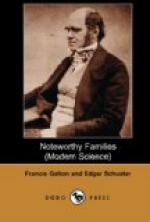The intensity with which any specified quality occurs in each or any degree of kinship is measured by the proportion between the numbers of those who possess the quality in question and the total number of persons in that same degree. Particular inquiries were made on the latter point, but, as already stated, the answers were incomplete. There is, however, enough information to justify three conclusions of primary importance to the present inquiry—namely, the average number (1) of brothers of the subject, (2) of brothers of his father, and (3) of brothers of his mother.
The number of Fellows to whom circulars were addressed was 467. The number of those who gave useful replies was 207, a little more than one-half of whom sent complete returns of the numbers of their brothers and uncles; some few of these had, however, placed a query here or there, or other sign of hesitation. As the number of completely available returns scarcely exceeded 100, I have confined the following tables to that number exactly, taking the best of the slightly doubtful cases. It would have been possible, by utilizing partial returns and making due allowances, to have obtained nearly half as many again, but the gain in numbers did not seem likely to be compensated by the somewhat inferior quality of the additional data.
The first three lines of Table V. show that there is no significant difference between the average numbers of brothers and sisters, nor between those of fathers’ brothers and fathers’ sisters, nor again between those of mothers’ brothers and mothers’ sisters; nor is there any large difference between those of male and female cousins, but it is apparently a fact that the group of “brothers” is a trifle smaller than that of uncles on either side. It seems, therefore, that the generation of the Subjects contains a somewhat smaller number of individuals than that of either of their Parents, being to that extent significant of a lessening population so far as their class is concerned.
TABLE V.—NUMBER OF
KINSFOLK IN ONE HUNDRED FAMILIES WHO
SURVIVED CHILDHOOD.
____________________________________________________________
__________
| | | |
| | | Generic | Specific
| Number of | Specific | Number of | | Kinships.
| Kinships. | Persons. | Kinships. | Persons.
| |_______________|_______________|___________|____________
__|___________|
| | | |
| | |Brothers and | bro
| 206 | si | 207
| | sisters | | |
| | |_______________|_______________|_
__________|______________|___________|
| | | |
| | |Uncles and | fa bro
| 228 | fa si | 207 |
| aunts | me bro | 219 |




